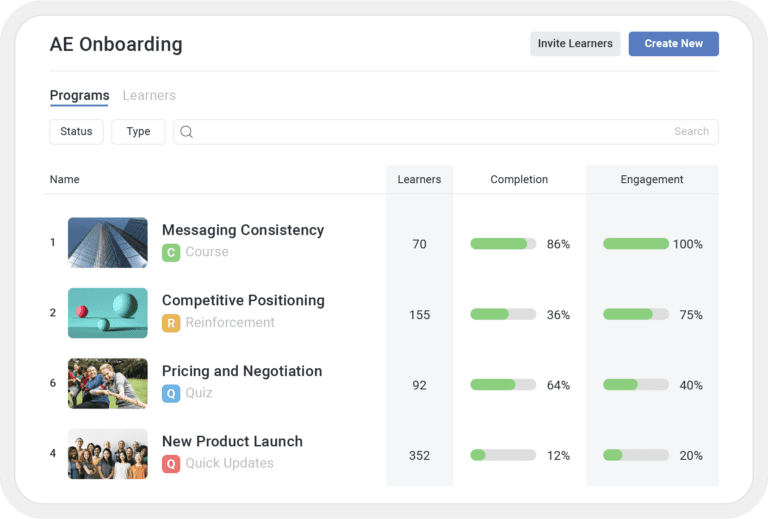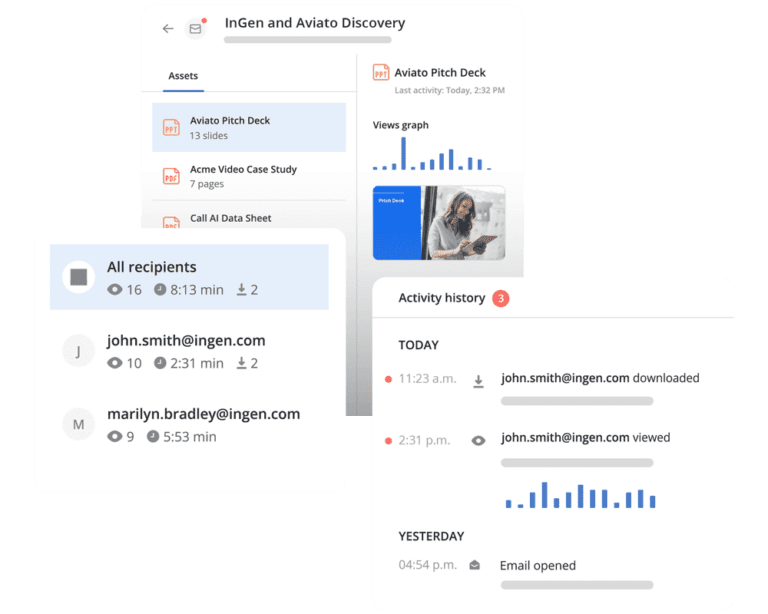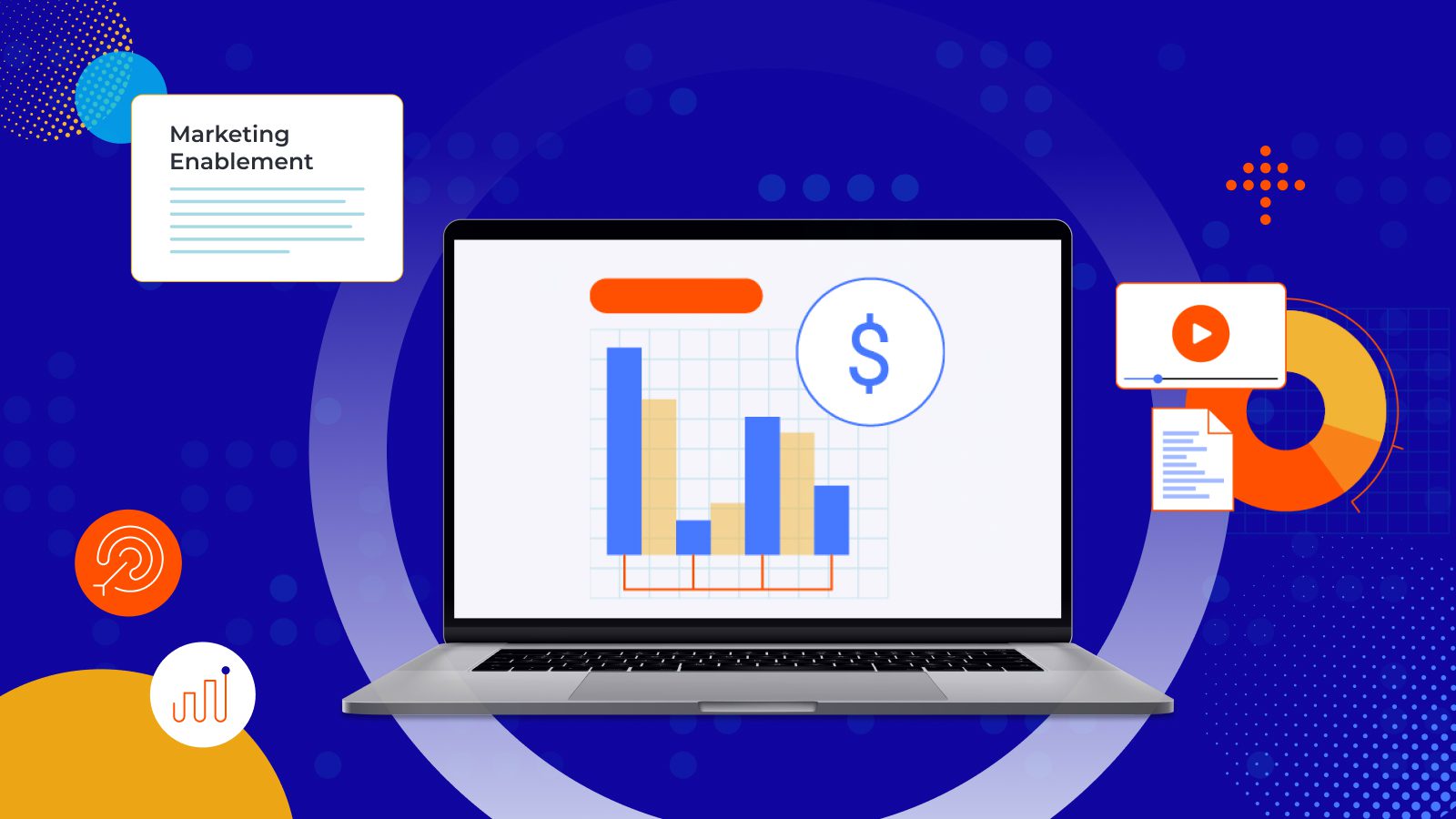Generic, one-size-fits-all marketing no longer works. Modern buyers expect personalized experiences – wherever they are on the purchase journey.
But often, organizations struggle to deliver marketing that resonates with buyers.
That’s where marketing enablement comes in.
In this post, we’ll explore what marketing enablement is, why it’s important, and how it differs from sales enablement. We’ll also share tips and best practices for an effective marketing enablement plan.
What is marketing enablement?
Today’s B2B buyers are more informed than ever. Oftentimes, they’ve done plenty of research on their own before engaging with a sales rep. In addition, these buyers have high expectations for outstanding experiences.
Marketing teams are under pressure to develop campaigns, content, and initiatives that resonate with these discerning buyers. Marketing enablement can help marketing teams deliver.
Let’s set the stage with a marketing enablement definition.
Essentially, marketing enablement is a practice focused on equipping marketing teams with the tools, data, information, and training they need to be better at their jobs. When marketing teams have what they need, they can create more effective, efficient campaigns and content that attract prospects and help move them through the funnel.
Marketing enablement helps ensure marketing teams better understand their buyers. This is foundational to any successful marketing program.
Marketing enablement also equips teams with the marketing enablement tools and resources they need to develop content and campaigns that engage buyers throughout the sales cycle.
Finally, marketing enablement also equips marketing teams with data (often, within a marketing enablement tool) that enables them to understand how (or whether) their content, campaigns, and other initiatives are impacting sales outcomes. With these insights, marketing teams can better align with sales and focus their attention on creating optimized content and campaigns that will improve sales outcomes.
Marketing enablement vs. sales enablement: What’s the difference?
In the world of B2B sales, marketing enablement, and sales enablement are two phrases we hear often. Sometimes, marketing enablement and sales enablement are even used interchangeably.
Both marketing enablement and sales enablement have the power to improve sales engagement and drive revenue growth. But marketing enablement and sales enablement aren’t the same thing.
Marketing enablement
Aims to improve the effectiveness and efficiency of marketing initiatives.
Sales enablement
Aims to ensure every seller is ready to take on any deal that comes their way.
Marketing enablement aims to improve the effectiveness and efficiency of marketing initiatives. The goal is to ensure marketing initiatives – including content and campaigns – resonate with buyers. Optimized marketing activities increase buyer engagement. When buyers are engaged, it’s easier for sales reps to shepherd them to the next stage of the purchase journey.
On the other hand, sales enablement aims to ensure every seller is ready to take on any deal that comes their way. Sales enablement teams collaborate with key teams including sales, marketing, and sales ops to identify the key skills and competencies a seller needs to be successful in the field. Then, they develop and deliver myriad initiatives – including onboarding, training, content, information, and coaching – that enable those sellers to develop the skills and competencies needed to close more deals.
While marketing enablement and sales enablement are different practices, there are some similarities.
As we’ve already covered, both marketing and sales enablement can positively impact buyers’ experiences and enable reps to close more deals. In addition, both practices rely on the right data and technology to drive their activities. For example, sales enablement can leverage data available in their sales enablement platform to determine how many sales reps completed a recent training – and whether it impacted seller performance. On the other hand, marketing teams can leverage data in a marketing enablement platform to determine whether a piece of content is being used – and whether it’s impacting the outcome of deals.

Finally, effective marketing enablement and sales enablement both require a customer-centric mindset. Teams must understand their buyers – including their key opportunities and challenges. These buyer personas must be the north star of any marketing enablement or sales enablement activity.
What are the key benefits of marketing enablement?
Marketing enablement isn’t exactly a new concept. But recently, a growing number of organizations have started to adopt this practice.
The growing popularity of marketing enablement isn’t surprising. Marketing enablement – when it’s done well – delivers plenty of benefits. Let’s take a look at a few.
Improved alignment between marketing and sales
All too often, marketing and sales teams act as adversaries, rather than partners. Per a LinkedIn report, nine in 10 sales and marketing professionals indicate they are misaligned around strategy, content, process, and culture.
Sales and marketing professionals think they're misaligned
This misalignment is costly. According to a Harvard Business Review article, misalignment between sales and marketing costs businesses an estimated $1 trillion each year.
Sales and marketing pros feel that aligned messaging and initiatives lead to better customer experiences.
Marketing enablement facilitates better alignment between these two key teams. Sales and marketing collaborate to ensure that marketing initiatives are aligned with sales processes and goals. This alignment allows for better experiences for buyers. The same LinkedIn report found that 90% of sales and marketing professionals feel that aligned messaging and initiatives lead to better customer experiences.
Of course, when customers have better experiences, they’re more likely to make a purchase.
More effective lead generation
A key responsibility of many marketing teams is to generate leads for the sales team. All too often, lead generation efforts fall short. Maybe a particular campaign delivered fewer leads than expected. Or perhaps another campaign generated a high volume of leads, but the conversion rate was extremely low because the leads weren’t a good fit for what sellers are offering.
Marketing enablement empowers marketing teams to boost their lead-generation efforts. By aligning with the sales process and understanding how buyers are engaging, marketing teams can develop compelling campaigns and content that attract a high volume of good-fit leads. Then, marketing can serve up these quality leads to the sales team, who can guide them through the sales process.
Better buyer engagement
Today’s buyers are more informed than ever before. Generic will no longer do. Instead, they expect content, information, and experiences that are tailored to their specific needs.
Marketing enablement ensures marketing teams have the data, tools, and resources they need to develop content, campaigns, and messaging that resonate with buyers throughout the purchase journey. When buyer engagement increases, so too does purchase likelihood.
Increased content ROI
In the past, marketing teams would develop and launch marketing campaigns and content – and then hope for the best. There was no easy way to understand how buyers and sellers were (or weren’t) engaging with content – and how specific content and campaigns were (or weren’t) impacting sales outcomes.
With marketing enablement, marketing teams have access to rich data and analytics that help them understand how their initiatives are performing. This includes:
- Whether a piece of content is being used
- How a piece of content is being used by both sellers and buyers
- How an initiative is impacting revenue
With this insight, marketers can make optimizations, prioritize their time and effort on what’s proven to work, and drive better ROI from their content, campaigns, and other efforts.

Tips for an effective marketing enablement plan
The importance of marketing enablement is clear. Marketing enablement – when it’s done well – can enhance marketing effectiveness and efficiency. Better marketing leads to better sales outcomes.
But what does an effective marketing enablement plan look like? There’s no easy answer. It depends on many factors, including size, industry, and marketing scope – among others.
However, there are some best practices for developing a successful marketing enablement plan.
What are the goals of your marketing enablement efforts? Be sure to document them. For example, you might aim to increase lead generation or improve the ROI of your content.
Be sure your goals are specific and measurable. In addition, they should align with the goals of your sales team and the organization as a whole.
A marketing enablement plan shouldn’t be created solely by the marketing team. Instead, it should be a collaborative effort, incorporating input from teams including sales and sales enablement.
Sales teams know their customers best. They can provide valuable insight into what is resonating with buyers – and what is making it easier (or harder) to close deals.
Marketing should also collaborate with sales enablement. After all, sales enablement teams help ensure sellers understand how to use the content that’s available to them.
One of the foundational steps of marketing enablement is to take an inventory of all existing marketing assets. Once all content is accounted for, the marketing team can determine which assets need to be refreshed and which should be eliminated.
After your content inventory is complete, map your existing assets to the customer journey. This exercise can help you understand where there is a need for additional marketing support.
Taking inventory of content seems simple enough. But that’s not always the case.
Oftentimes, marketing content is stored in multiple, disparate systems. It can be challenging to get a handle on all content.
A best practice is to store all marketing content in a single system of record. A content management system within a sales productivity platform is an ideal marketing enablement tool.
Storing your content in a central location ensures your sales reps can always find the latest and greatest versions of the content they need for any sales scenario. In addition, a content management system makes it easy to update, delete, or add new content.
Once you’ve developed new content and campaigns, it’s important to ensure sellers know about it. Sales reps need to understand how marketing initiatives fit in with their sales process – and how they can use marketing content to move deals forward.
Be sure to partner with the sales enablement team to develop a plan for enabling sellers.
Data is a critical component of an effective marketing enablement strategy. Be sure you’re tapping into technology to measure the effectiveness of your messaging, content, and campaigns. Then, use this data to optimize accordingly.
For example, you can leverage your sales productivity platform to understand how buyers and sellers are engaging with a particular piece of content and how it is (or isn’t) improving deal outcomes. These insights can be used to optimize content.
In addition, ask for feedback from sales on an ongoing basis. Sales reps are meeting with customers all day. They have a good understanding of what’s working and what’s not.
Supercharge your marketing enablement strategy with Mindtickle
Modern buyers have high expectations for outstanding experiences. Generic marketing initiatives won’t cut it.
Today, a growing portion of organizations are turning to marketing enablement to deliver marketing that resonates with buyers throughout the sales cycle. It’s a win-win for marketing and sales alike. Better marketing leads to greater customer engagement. Engaged buyers are more likely to make a purchase.
Effective marketing enablement requires the right marketing enablement tools. Today, some of the world’s best organizations turn to Mindtickle to supercharge their marketing enablement strategy.
With Mindtickle’s integrated revenue productivity platform, sellers can easily access the content they need in any sales scenario. They can leverage training and coaching to better understand how to use the content and messaging that’s available to them.
Marketing teams turn to Mindtickle to understand how sales reps and buyers are engaging with content – and whether it’s impacting sales results. Marketing teams can use these insights to make optimizations that lead to better performance and ROI.
Enablement in Mindtickle
Ready to see how Mindtickle can boost the effectiveness and efficiency of your marketing? Contact us to schedule a live, personalized demo.
Get a Demo


 By Helen Waite
By Helen Waite
 By Christian Pieper
By Christian Pieper
